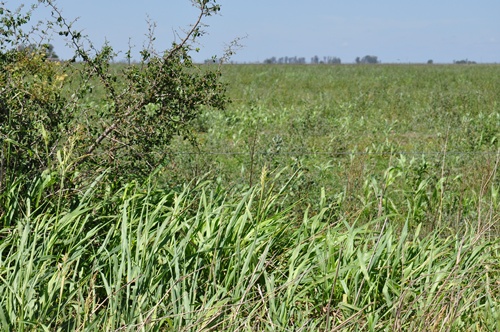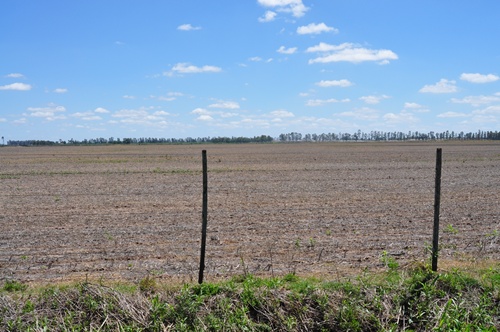Soya is big business in Argentina. Argentineans themselves aren’t great consumers of soya, you’d probably have to go hunting in the larger supermarkets if you actually wanted to eat the stuff. Domestic consumption is mainly in the form of animal feed, but world soya prices went through the roof a couple of years back and Argentina is one of the largest producers of it. We live in the heart of one of the most productive growing areas where soya has taken over from the more traditional forms of land-use; cows, maize, sunflowers, barley.
Argentina is also one of the countries where genetic modification is permitted, so our soya is modified to withstand being sprayed by toxic chemicals (e.g. Roundup) to stop the weeds from coming through. Our bit of Argentina is extremely fertile, the saying goes that if you throw a seed at the ground a crop will appear. In the short fallow period between one crop being harvested and the next one being planted a field quickly becomes a jungle;
I’m not actually sure what the field above had in it previously. Sunflowers? Maybe sweetcorn. However, also harvested a couple of months ago, just on the other side of the track, the field below had been planted with soya. Notice anything different?
Now I’m not an agriculturalist, but I suspect that the only thing that might grow in this barren land would be some more modified soya, which will be sprayed with some more heavy chemicals. Am I spotting a cycle?
There is a rumour that unless the land is left to rest for at least a year between soya crops then within five to seven years the land is wasted. Another rumour says that the land-owners who are currently making their money from soya are now rushing to invest it in blocks of luxury flats in the up and coming areas of Cordoba. With such commitments to diversifying and long-term planning we won’t need to worry about Argentina putting all their eggs in one basket when the land becomes a desert. So that’s all OK then.

